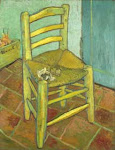A couple more websites have picked up the story of the "Van Gogh" notebook in Greece. I've seen better pictures now, and well, I don't think the VGM curators are going to be falling all over themselves on this one. The owner evidently does believe it dates from 1880 while van Gogh was in Brussels and that the notebook represents his thoughts about works he would do in future. Considering that he hadn't even MET the models in the sketches--Sien Hoornik, Julien Tanguy, Cornelia de Groot--that would be quite a feat.
But let's say the notebook belonged to an art student in 1930s Brussels. What was s/he looking at? 3 of the 60 sketches have been shown in news photos: a detail of "Potato Eaters," a sketch after "Sorrow" (of which there are two drawings and one lithograph done by Vincent); and part of a portrait of Père Tanguy (Vincent did two paintings and one drawing showing Tanguy with a hat). According to Faille's 1970 catalogue raisonnée, none of those were exhibited together in the 1930s. So the art student probably did not sketch from the actual pictures. My theory? S/he was looking at the 1928 edition of Faille's catalogue, which was published--guess where?--in Brussels.
The Nazi stamp, if authentic, raises more questions that can't be answered. Vincent was on the Nazi blacklist of "degenerate artists," his works confiscated from German museums and private collections along with those of other modernist artists. Some van Goghs were tucked quietly into storage, others auctioned to raise money for the Nazi cause, and others just...disappeared. Did a Nazi soldier think the notebook was a van Gogh original? Or even if he didn't, was it taken from its original owner by force, kept as a souvenir of a raid? Or here's the question that sends chills up my spine: what happened to the person who drew those pictures?
Subscribe to:
Post Comments (Atom)






No comments:
Post a Comment